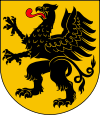Gdynia
| Gdynia | |||
|---|---|---|---|
 |
|||
|
|||
| Motto: Gdynia - miasto z morza i marzeń (Gdynia - a city built of sea and dreams) |
|||
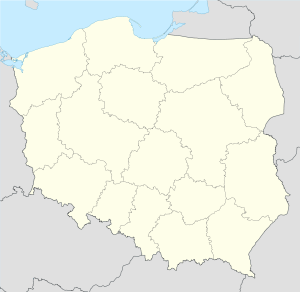 Gdynia
|
|||
| Coordinates: | |||
| Country | |||
| Voivodeship | Pomeranian | ||
| County | city county | ||
| City rights | February 10, 1926 | ||
| Boroughs | 22 dzielnicas | ||
| Government | |||
| - Mayor | Wojciech Szczurek | ||
| - Vice President | Ewa Łowkiel | ||
| - Vice President | Michał Guć | ||
| - Vice President | Bogusław Stasiak | ||
| - Vice President | Marek Stępa | ||
| Area | |||
| - Total | 136 km2 (52.5 sq mi) | ||
| Highest elevation | 205 m (673 ft) | ||
| Lowest elevation | 0 m (0 ft) | ||
| Population (2009) | |||
| - Total | 248,889 | ||
| - Density | 1,830.1/km2 (4,739.8/sq mi) | ||
| Time zone | CET (UTC+1) | ||
| - Summer (DST) | CEST (UTC+2) | ||
| Postal code | 81-004 to 81-919 | ||
| Area code(s) | +48 58 | ||
| Car plates | GA | ||
| Website | http://www.gdynia.pl | ||
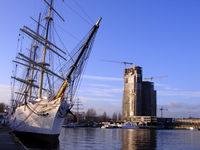

Gdynia [ˈɡdɨɲa] (![]() listen) (Kashubian: Gdiniô, German: Gdingen) is a city in the Pomeranian Voivodeship of Poland and an important seaport of Gdańsk Bay on the south coast of the Baltic Sea.
listen) (Kashubian: Gdiniô, German: Gdingen) is a city in the Pomeranian Voivodeship of Poland and an important seaport of Gdańsk Bay on the south coast of the Baltic Sea.
Located in Kashubia in Eastern Pomerania, Gdynia is part of a conurbation with the spa town of Sopot, the city of Gdańsk and suburban communities, which together form a metropolitan area called the Tricity (Trójmiasto), with a population of over a million people.
Contents |
History
The area of the later city of Gdynia shared its history with Pomerelia (Eastern Pomerania); in prehistoric times it was the center of Oksywie culture; it was later populated by Slavs with some Baltic Prussian influences.
- Late 10th century: Pomerelia was united with Poland.[1]
- During the reign of Mieszko II Pomerelia seceded from Poland and became independent.
- 1116/1121: Bolesław III reunited Pomerelia with Poland.[2]
- 1209: First mention of Oxhöft (now known as Oksywie, which is now a part of Gdynia).
- 1227: Pomerelia again became an independent Duchy.
- 1253: First known mention of the name "Gdynia", as a Pomeranian (Kashubian) fishing village. The first church on this part of the Baltic Sea coast was built there.
- 1294: Pomerelia was inherited by the future Polish king Przemysł II., and remained as part of Poland until –
- 1309-1310; The Teutonic Order conquered Pomerelia and added it to Prussia.
- 1380: The owner of the village which became Gdynia, Peter from Rusocin, gave the village to the Cistercian Order.
- 1382: Gdynia became property of the Cistercian abbey in Oliva, now Oliwa.
- 1454; Thirteen Years' War started.
- 1466: Thirteen Years' War ended. Pomerelia became part of Royal Prussia, a newly established province of the Kingdom of Poland [3], and later on of the Polish-Lithuanian Commonwealth.
- 1772: In the First Partition of Poland, Royal Prussia (including Gdynia) was annexed into the Kingdom of Prussia. Gdynia became known in German as Gdingen, and was expropriated from the Cistercian Order.
- 1789: There were only 21 houses in Gdynia.
- 1870:
- The Kingdom of Prussia became part of the German Empire.
- The village of Gdingen had some 1,200 inhabitants, and it was not a poor fishing village as it is sometimes described. It was a popular tourist spot with several guest houses, restaurants, cafes, several brick houses and a small harbour with a pier for small trading ships. The first Kashubian mayor of Gdingen was Jan Radtke.
- 1919: Treaty of Versailles and the start of the dismemberment of eastern Germany.
- 1920: Gdingen (now named Gdynia), along with other parts of former West Prussia, became a part of the new Republic of Poland; simultaneously, the city of Danzig and surrounding area was declared a free city and put under the League of Nations, though Poland was given economic liberties and requisitioned for matters of foreign representation.
Construction of the seaport
The decision to build a major seaport at the Gdynia village was made by the Polish government in the winter of 1920,[4] in the midst of the Polish-Soviet War (1919–1920). The authorities and seaport workers of the Free City of Danzig felt Poland's economic rights in the city were being misappropriated to help fight the war. The workers went on strike, and Poland realized the need for a port city it was in complete control of, economically and politically.
Construction of Gdynia seaport was started in 1921, but because of financial difficulties was conducted slowly and with interruptions. It was accelerated after the Sejm (Polish parliament) passed the Gdynia Seaport Construction Act on 23 September 1922. By 1923 a 550-metre pier, 175 metres of a wooden tide breaker, and a small harbour had been constructed. Ceremonial inauguration of Gdynia as a temporary military port and fishers' shelter took place on 23 April 1923, and the first major seagoing ship arrived on 13 August 1923.
To speed up the construction works, the Polish government in November 1924 signed a contract with the French-Polish Consortium for Gdynia Seaport Construction, which by the end of 1925 had built a small seven-metre-deep harbour, the south pier, part of the north pier, a railway, and had also ordered the trans-shipment equipment. The works were going more slowly than expected, however. They accelerated only after May 1926, because of an increase in Polish exports by sea, economic prosperity, the outbreak of the German–Polish trade war which reverted most Polish international trade to sea routes, and also thanks to the personal engagement of Eugeniusz Kwiatkowski, Polish Minister of Industry and Trade, also responsible for construction of Centralny Okręg Przemysłowy. Till the end of 1930 docks, piers, breakwaters and many auxiliary and industrial installations were constructed (such as depots, trans-shipment equipment, and a rice processing factory) or started (such as a large clod room).
Trans-shipments rose from 10,000 tons (1924) to 2,923,000 tons (1929). At this time Gdynia was the only transit and special seaport designed for coal exports. In the years 1931–1939 the Gdynia harbour was further extended to become a universal seaport. In 1938 Gdynia was the largest and most modern seaport on the Baltic Sea, as well as the tenth biggest in Europe. The trans-shipments rose to 8.7 million tons, which was 46% of Polish foreign trade. In 1938 the Gdynia shipyard started to build its first full-sea ship, the Olza.
Construction of the city
The city was constructed later than the seaport. In 1925 a special committee was inaugurated to build the city; city expansion plans were designed and city rights were granted in 1926, and tax privileges were granted for investors in 1927. The city started to grow significantly after 1928 and the population grew rapidly to over 120,000 in 1939.
In 1930 the Baltic Institute in Toruń, an institution designed to research Polish heritage in Pomerania, opened its branch in Gdynia.
During World War II (1939–1945)
The city and seaport were occupied in September 1939 by German troops and renamed Gotenhafen after the Goths, an ancient Germanic tribe, who had lived around there. Some 50,000 Polish citizens, who after 1920 had been brought into the area by the Polish government, after the decision to enlarge the harbour was made, were expelled into the General Gouvernment. Kashubians who were suspected to support the Polish cause, particularly those with higher education, were arrested and executed, the main place of executions being Piaśnica (Groß Plaßnitz), where according 12,000 were executed. The German administrator of the area Albert Forster considered Kashubians of "low value" and did not support any attempts to create Kashubian nationality. Some Kashubians organized anti-Nazi resistance groups, "Gryf Kaszubski" (later "Gryf Pomorski"), and the exiled "Zwiaziek Pomorski" in Great Britain.
The harbour was turned into a German naval base. The shipyard was expanded in 1940 and became a branch of the Kiel shipyard (Deutsche Werke Kiel A.G.). Gotenhafen became an important German naval base, due to its being relatively distant from the war theater, and many German large ships - battleships and heavy cruisers were harbored there. Both the seaport and the shipyard witnessed several air raids by the Allies from 1943 onwards, but suffered little damage. The seaport area was largely destroyed by withdrawing German troops and millions of encircled refugees in 1945 being bombarded by Soviet Military (90% of the buildings and equipment were destroyed) and the harbour entrance was blocked by the German battlecruiser Gneisenau that had been brought to Gotenhafen for major repairs.
The city was also the location for the Nazi concentration camp Gotenhafen, a subcamp of the Stutthof concentration camp near Gdansk (Danzig).
The harbour of Gotenhafen was also used in winter 1944-45 to evacuate German troops and refugees trapped by the Red Army. Some of the ships were hit by torpedoes from Soviet submarines in the Baltic Sea on the route West. For example, the ship Wilhelm Gustloff sank taking about 9,400 people with her– the worst loss of life in a single sinking in maritime history.
After World War II
On March 28, 1945, Gotenhafen was captured by the Soviets and assigned to Polish Gdańsk Voivodeship, who again re-named it Gdynia.
In the Polish 1970 protests, worker demonstrations took place at Gdynia Shipyard. Workers were fired upon by the police. The fallen became symbolized by a fictitious worker Janek Wiśniewski, commemorated in a song by Mieczysław Cholewa, Pieśń o Janku z Gdyni. One of Gdynia's important streets is named after Janek Wiśniewski. The same person was portrayed by Andrzej Wajda in his movie Man of Iron as Mateusz Birkut.
On December 4, 1999, a storm destroyed a huge crane in a shipyard, which was able to lift 900 tons.[5]
Economy
Notable companies that have their headquarters in Gdynia:
- Stocznia Gdynia, the largest Polish shipyard
- PROKOM SA, the largest Polish I.T. company
- C. Hartwig Gdynia SA, one of the largest Polish freight forwarders
Transport
Port of Gdynia

In 2007, 364,202 passengers, 17,025,000 tons of Cargo and 614,373 TEU containers passed through the port.
Airport
An airport serving the city (Gdynia-Kosakowo Airport) is situated in the village of Kosakowo, just to the north of the city. The conurbation's main airport, Gdańsk Lech Wałęsa Airport, lays approximately 15 kilometres (9.3 mi) south-west of central Gdynia.
Road transport
Trasa Kwiatkowskiego links Port of Gdynia and the city with Obwodnica Trójmiejska, and therefore A1 motorway.
Education

There are currently 8 universities and institutions of higher education based in Gdynia. Many students from Gdynia attend also universities located in the Tricity.
- State-owned:
- Gdynia Maritime University
- Polish Naval Academy
- University of Gdansk - departments of Biology, Geography and Oceanology
- Privately owned:
- Academy of International Economic and Political Relations
- Kwiatkowski Graduate School of Business Administration
- Pomeranian Higher School of Humanities
- Cardinal Stefan Wyszynski University - department in Gdynia
- Higher School of Social Communication
Sports
Sport teams
- Arka Gdynia - men’s football team (Polish Cup winner 1979, currently plays in the top division of Polish football, the Ekstraklasa)
- Bałtyk Gdynia - men's football team, playing in the 2nd league in the season 2009/2010;
- Lotos Gdynia - women’s basketball team (Polish Champion 2004 in Sharp Torell Basket Liga)
- Asseco Prokom Gdynia - men’s basketball team (Dominet Bank Ekstraliga)
- RC Arka Gdynia - rugby team (Champions of Poland in seasons 2003/2004 & 2004/2005)
- Kager Gdynia - men’s basketball team (Dominet Bank Ekstraliga)
- KS Laczpol Gdynia - women’s handball team (1st league in season 2003/2004)
Sights and tourist attractions
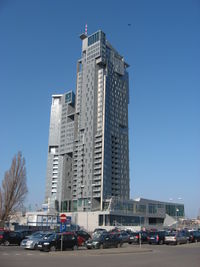
Gdynia is a relatively modern city, but the oldest building in Gdynia is nevertheless the 13th century St. Michael the Archangel's Church in Oksywie. There is also a 17th century neo-Gothic manor house located on Folwarczna Street in Orłowo. However, what attracts most tourists in Gdynia deals with its recent past. In the harbour, there are two anchored museum ships, the ORP Blyskawica destroyer and the Dar Pomorza Tall ship frigate.
Gdynia is famous for its numerous examples of early 20th century architecture, especially monumentalism and early functionalism, and modernism. Great example of modernism is PLO building situated at 10 lutego street. Recently reconstructed Świętojańska street and Kościuszko square are also worth a mention. The surrounding hills and the coastline attract many nature lovers. A leisure pier and a cliff-like coastline in Kępa Redłowska, as well as the surrounding Reservation Park, are also popular locations. A 1.5 kilometre long promenade leads from the marina in the city centre, to the beach in Redłowo. Most of Gdynia can be seen from Kamienna Góra (54 metres asl) or a newly built observation point near Chwaszczyno. You can also take a hydrofoil or ship trip to Gdańsk Westerplatte, Hel or just see the port.
There are also two observation towers, one at Góra Donas, the other at Kolibki. The third one, on the 38th floor of the Sea Towers building, will be probably opened to visitors in 2009. Gdynia is remarkable for this construction, since at 141 meters of height, it is the tallest residential building in Poland and the country's tallest skyscraper outside of Warsaw.
Gdynia is also the host of the Heineken Open'er Festival, one of the biggest contemporary music festivals in Poland. The festival welcomes many foreign hip-hop, rock and electronic music artists every year. The second most important summer event in Gdynia is Viva Beach Party, which is a large two-day techno party made on Gdynia's Public Beach, usually held in August. Gdynia also host some events for the annual Gdańsk Shakespeare Festival.
Modern division into neighbourhoods
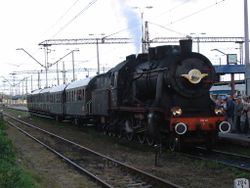
- Babie Doły
- Chwarzno Wiczlino
- Chylonia
- Cisowa
- Działki Leśne
- Dąbrowa
- Grabówek
- Kamienna Góra
- Karwiny
- Leszczynki
- Mały Kack
- Obłuże
- Oksywie
- Orłowo
- Pogórze
- Pustki Cisowskie-Demptowo
- Redłowo
- Śródmieście
- Wielki Kack
- Witomino Leśniczówka
- Witomino Radiostacja
- Wzgórze Św. Maksymiliana
Population and area

| Year | Inhabitants | Area |
|---|---|---|
| 1870 | 1200 | |
| 1920 | 1300 | |
| 1926 | 12,000 | 6 km² |
| 1939 | 127,000 | 66 km² |
| 1945 | 70,000 | 66 km² |
| 1960 | 150,200 | 73 km² |
| 1970 | 191,500 | 75 km² |
| 1975 | 221,100 | 134 km² |
| 1980 | 236,400 | 134 km² |
| 1990 | 251,500 | 136 km² |
| 1994 | 252,000 | 136 km² |
| 1995 | 251,400 | 136 km² |
| 2000 | 255,420 | 135.49 km² (after GUS - Central Statistical Office in Warsaw) |
| 2009 | 248,889 | 136 km² |
Notable people
- Antoni Abraham (1869–1923), Kashubian representative to the Versailles Treaty, political activist and proponent of Polish Kashubia
- Józef Michał Hubert Unrug (1884–1973), German-born Polish vice admiral who helped create the Polish navy
- Franciszek Stefan Sokół (1890–1956) Polish author, Commissioner of the government of Gdynia and the city's chief promoter and defender
- Antoni Suchanek (1901–1982), Polish maritime painter
- Karol Olgierd Borchardt (1905–1986), Polish maritime author and educator
- Kazimierz Ostrowski (1917 Berlin - 1999 Gdynia) Polish painter
- Zbigniew Szczepanek (b. 1933) Polish author of maritime textbooks, considered one of the best watercolor artists in Europe
- Jacek Fedorowicz (b. 1937), Polish satirist and actor
- Gunnar Heinsohn (* 1943), German scientist
- Jörg Berger (*1944-2010), German soccer player, trainer
- Klaus Hurrelmann (* 1944), German scientist
- Franciszka Cegielska (1946–2000), Polish politician and Solidarity movement activist
- Marcin Mięciel (* 1975), soccer player
- Michael Klim (* 1977), Polish-born Australian swimmer, world champion
- Adam Darski, Lead Vocals/ Lead Guitar for the Blackened Death Metal band Behemoth
- Stefan Liv, Swedish ice hockey player
- Monika Pyrek Pole vaulter
- Anna Rogowska Pole vaulter
International relations
Twin towns — sister cities
Gdynia is twinned with:
 Aalborg in Denmark[6]
Aalborg in Denmark[6] Kaliningrad, Russia
Kaliningrad, Russia Plymouth, England, UK
Plymouth, England, UK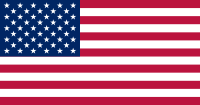 Seattle, USA
Seattle, USA Aalborg, Denmark
Aalborg, Denmark Baranovichi, Belarus
Baranovichi, Belarus Brooklyn, USA
Brooklyn, USA Haikou, China
Haikou, China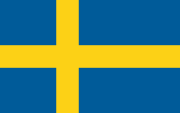 Karlskrona, Sweden
Karlskrona, Sweden Syndicat Mixte de la Côte d'Opale, France
Syndicat Mixte de la Côte d'Opale, France Kristiansand, Norway
Kristiansand, Norway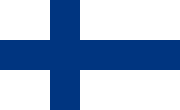 Kotka, Finland
Kotka, Finland Liepāja, Latvia
Liepāja, Latvia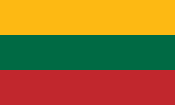 Klaipėda, Lithuania
Klaipėda, Lithuania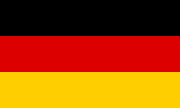 Kiel, Germany
Kiel, Germany
Cultural references
In 2008, Gdynia made it onto the Monopoly Worldwide Edition board after being voted by fans through the internet. Gdynia occupies the space traditionally held by Mediterranean Avenue, being the lowest voted city to make it onto the Monopoly Here and Now board, but also the smallest city to make it in the game. All of the other cities are large and widely known ones, the second smallest being Riga. The unexpected success of Gdynia can be attributed to a mobilization of the town's population to vote for it on the internet.
An abandoned factory district in Gdynia was the scene for the survival series Man vs Wild, season 6, episode 12. The host, Bear Grylls, manages to escape the district after blowing up a door and crawling thru miles of sewer.
Ernst Stavro Blofeld, the supervillain in the James Bond novels, was born in Gdynia on May 28, 1908, according to Thunderball.
See also
- Donas
- Gdynia trolleybus
- Hydrofoil
- Ports of the Baltic Sea
References
- ↑ André Vauchez, Richard Barrie Dobson, Adrian Walford, Michael Lapidge,Encyclopedia of the Middle Ages, Routledge 2000, p.: 1163, ISBN 1579582826 link
- ↑ James Minahan, One Europe, Many Nations: A Historical Dictionary of European National Groups, Greenwood Publishing Group, 2000, p.375, ISBN 0313309841
- ↑ Daniel Stone,A History of East Central Europe, University of Washington Press, 2001, p. 30, ISBN 0295980931 Google Books
- ↑ World Port Source - Gdynia
- ↑ "Catastrophic collapses of architectural structures in Poland". SkyscraperCity. http://www.skyscrapercity.com/showthread.php?p=20126430#post20126430. Retrieved 2009-05-05.
- ↑ "Aalborg Kommune - Venskabsbyer". Web.archive.org. 2007-11-14. http://web.archive.org/web/20071114155748/http://www.aalborgkommune.dk/Borgerportal/Serviceomraader/Byen/Venskabsbyer/Towns.htm. Retrieved 2009-07-26.
Further reading
- (ed.) R. Wapiński, Dzieje Gdyni, Gdańsk 1980
- (ed.). S. Gierszewski, Gdynia, Gdańsk 1968
- Gdynia, in: Pomorze Gdańskie, nr 5, Gdańsk 1968
- J. Borowik, Gdynia, port Rzeczypospolitej, Toruń 1934
- B. Kasprowicz, Problemy ekonomiczne budowy i eksploatacji portu w Gdyni w latach 1920-1939, Zapiski Historyczne, nr 1-3/1956
- M. Widernik, Główne problemy gospodarczo-społeczne miasta Gdyni w latach 1926-1939., Gdańsk 1970
- (ed.) A. Bukowski, Gdynia. Sylwetki ludzi, oświata i nauka, literatura i kultura, Gdańsk 1979
- Gminy województwa gdańskiego, Gdańsk 1995
- H. Górnowicz, Z. Brocki, Nazwy miast Pomorza Gdańskiego, Wrocław 1978
- Gerard Labuda (ed.), Historia Pomorza, vol. I-IV, Poznań 1969-2003
- (ed.) W. Odyniec, Dzieje Pomorza Nadwiślańskiego od VII wieku do 1945 roku, Gdańsk 1978
- L. Bądkowski, Pomorska myśl polityczna, Gdańsk 1990
- L. Bądkowski, W. Samp, Poczet książąt Pomorza Gdańskiego, Gdańsk 1974
- B. Śliwiński, Poczet książąt gdańskich, Gdańsk 1997
- Józef Spors, Podziały administracyjne Pomorza Gdańskiego i Sławieńsko-Słupskiego od XII do początków XIV w, Słupsk 1983
- M. Latoszek, Pomorze. Zagadnienia etniczno-regionalne, Gdańsk 1996
- B. Bojarska, Eksterminacja inteligencji polskiej na Pomorzu Gdańskim (wrzesień-grudzień 1939), Poznań 1972
- K. Ciechanowski, Ruch oporu na Pomorzu Gdańskim 1939-1945., Warszawa 1972
External links
|
|||||||
|
||||||||||
|
|||||||


